Sound + Vision
By Valerie Xanos
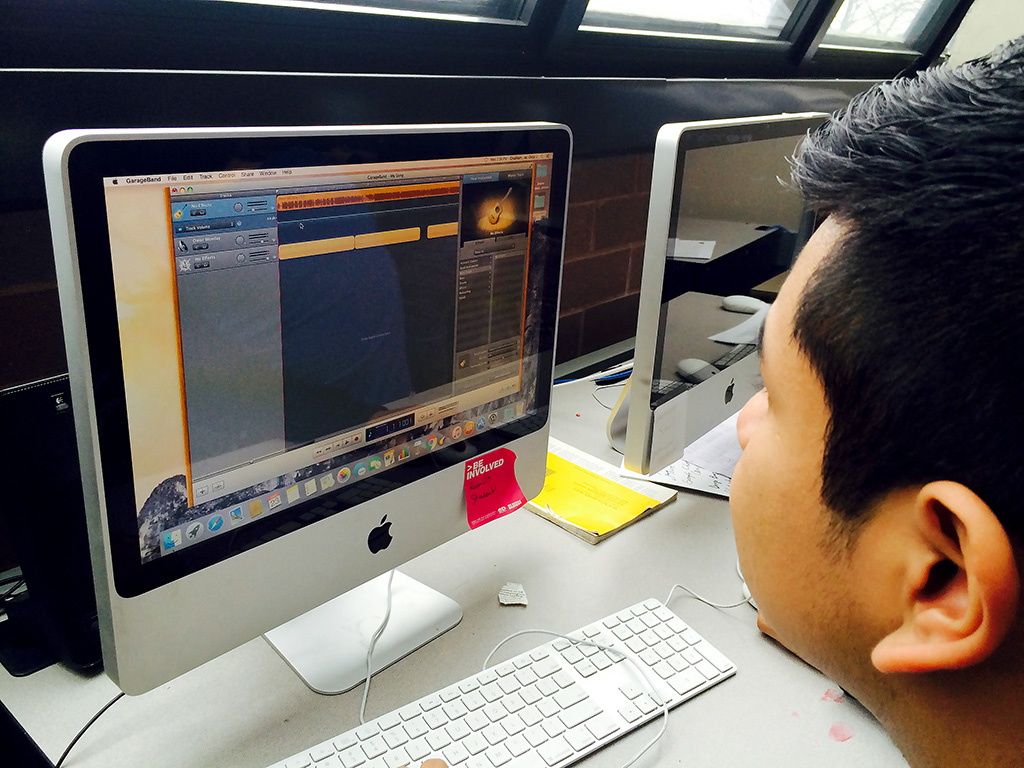
To advocate for the power and presence of art in school and community culture, students functioned as an artists’ collective, collaborating on the creation of a multi-media installation in the school community. They recorded sounds from their school and neighborhood that define their identity as artists and arranged/edited them into a digital Soundscape (an experimental musical piece that served as a collective Audiological Self-Portrait). They simultaneously created Sound Sculptures to be used in an interactive performance while the Soundscape plays over loud speakers.

Goals + Objectives
ARTISTS’ COLLECTIVE:
- Students will work as an artist’s collective to design their theme and curriculum for the year. The teacher acts as facilitator, organizer, and technical advisor of the project, teaching artistic practice / process and creative autonomy rather than specific skills or techniques.
- Students will have autonomy in expressive, organizational, curricular, creative, and curatorial decisions through the democratic process.
- Students will work collaboratively in “Working Crews” to ensure productivity and efficiency as they develop the visual/sound installation and performance. Each crew has an elected leader who guides crew members, maintains deadlines, and reports progress to the teacher and other crew leaders weekly. Each crew has a member who documents and blogs the project process for the benefit of the collective and our blog followers.
INSPIRATIONS:
- Students will be inspired by The Freedom Principle, which features art and music created and inspired by Chicago artist collectives. Students will work with an artist-in-residence, Mikel Patrick Avery, who is an experimental musician and visual/performance artist, to gain insight into the practice of a professional artist whose work is similar in scope to their own ambitions.
THEMATIC CONCEPT: ARTS ADVOCACY AND COLLECTIVE IDENTITY
- Students will develop specific thematic concepts for their projects starting with the common theme of Arts Advocacy.
- Students will express their concept through a multimedia work that is composed of visual and sound elements.
- Students will advocate for the arts through their installation/performance and by writing a manifesto that calls for social action to protect the arts.
Guiding Questions
- Who are we as a collective of artists? How do we express our collective identity?
- How can we embrace the responsibility, power, and autonomy that comes with the title of “artist”?
- How can we be SEEN and HEARD as respected artists in an educational system based on privilege and inequity?
- What is our collective manifesto regarding Arts Advocacy?
- What is sound / silence / music?
- How will we interpret sound visually ?
- How will we curate our visual, audio, and performative work as a cohesive whole?
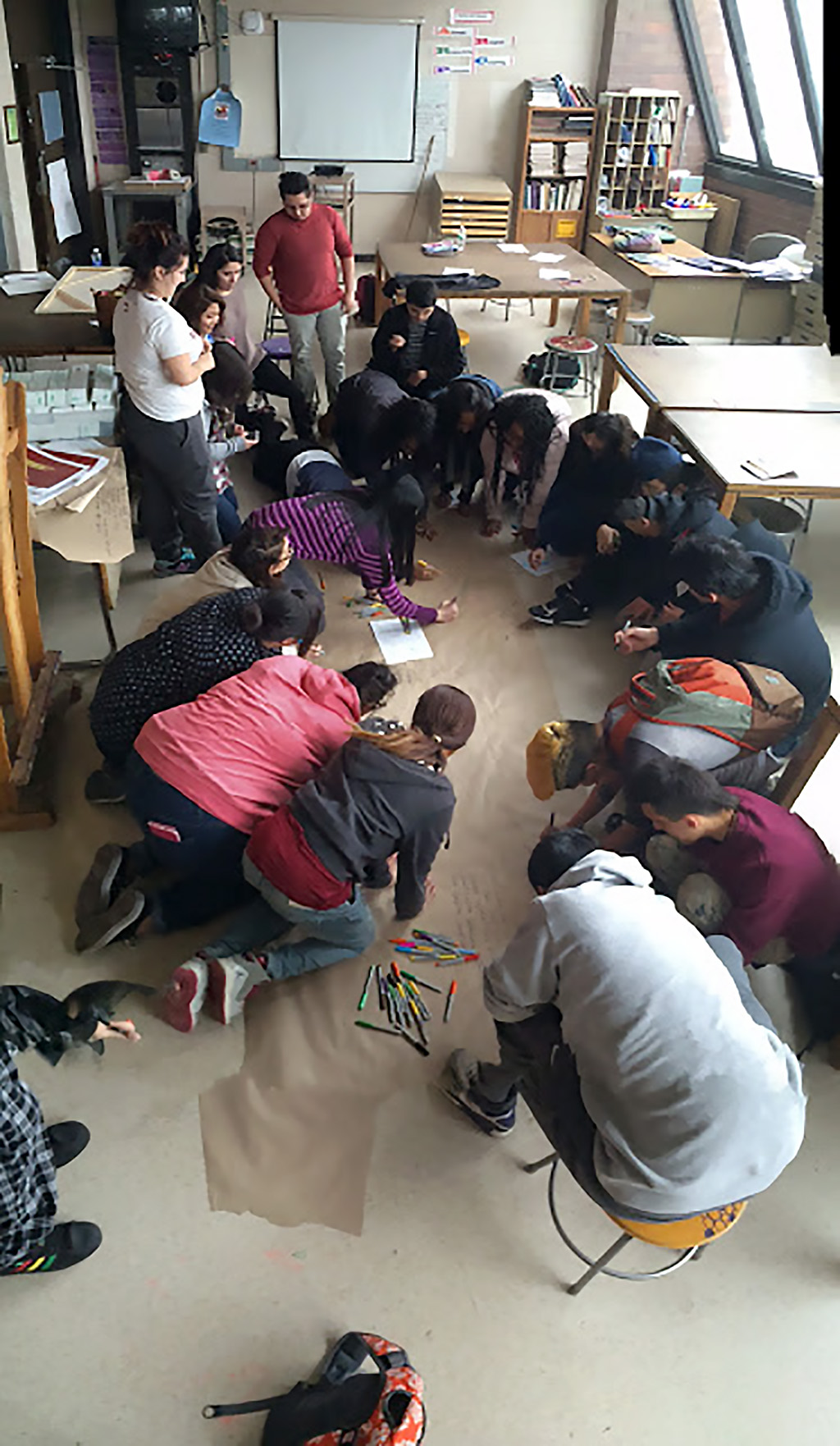
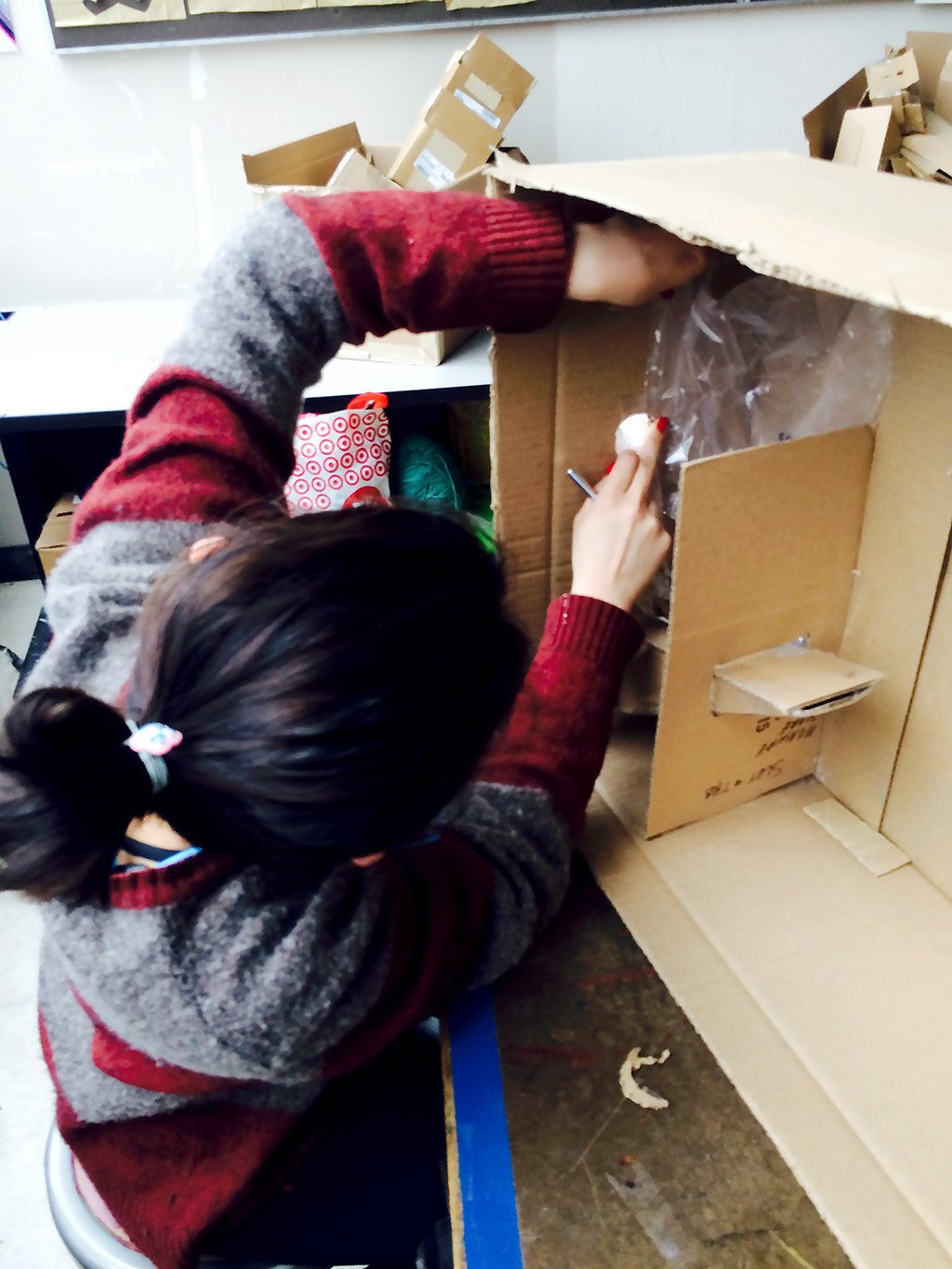
Documentation + Assessment
- Students documented their creative process through video, audio, and photos posted on our collaborative blog.
- Students assessed their progress throughout the project via group discussion, critiques, written plans, a collectively developed rubric, and blog postings.
Timeframe + Learning Activities
Timeframe
- September–October: Collective Learning and Practice
- October: Introduction - The Freedom Principle
- November: Building the Collective - ME/WE
- December: Expressive Visual Interpretation of Sound with Mikel Patrick Avery
- January: Sound Sculptures
- February: Concepts & Development
- March: Creating
- April: Final Creations
- May and June: Manifesto and Curation of Installation / Performance
Learning Activities
September–October: Collective Learning and Practice.
The Collective chose the main theme of Art Advocacy via discussion and activities that were designed to aid students in developing the theme. Examples: Mind Mapping, Coffee Can Talk, Artist Research/Analysis.
SHORT TERM PROJECT:
- A short term art project was developed to help build students’ skills in working collectively around the following question: How do we tell people what we think about Arts Advocacy?
- The answer was to create “Shout Out!” block prints of student portraits shouting “word art” statements declaring art’s importance in society and education.
Students learned and practiced block printing techniques, collaboratively producing over 100 prints. - They wrote, designed, and collaged the arts advocacy statements that accompanied the prints. They organized and formed crews, assigning jobs to crew members and problem-solving with the guidance of Crew Leaders. Crew Jobs included Printing, Developing Expressive Concepts, Writing Shout Out Statements, Collaging Statements as Word Art, Editing and Curating, Writing the Manifesto, Documenting Process on Blog.
October: Introduction - Exploring The Freedom Principle and learning from John Cage.
Students viewed the Freedom Principle exhibit at the MCA, focusing on works that fit our themes of Arts Advocacy and Collective Identity and on works that used both visual and sound media.
- The Long-Term Project Parameters were introduced: Sound and visual media, arts advocacy, and collective identity.
- Coffee Can Talk: Students write questions or topics on slips of paper. These are placed in a coffee can. Teacher pulls out slips and uses them as a catalyst for honest, open class discussion. Breakthrough: Question - “Why do we suffer from lack of access to the arts in our education and neighborhood?” Answers generated: “We are invisible, no one sees or hears us as artists. That way it is easy to ignore us.” “We have to be seen and heard as artists, then they can’t erase us.” “We have to tell our stories, show them who we are”.
- Listened to John Cage’s 4’33” (consisting of 4 minutes and 33 seconds of “silence”), which served as a catalyst for thoughts regarding collective identity. Students discovered they could hear all kinds of normally ignored ambient sounds that defined our collective space. Breakthrough: “WE are the Symphony!”, shouted by a student during a moment of clarity. This defining moment inspired the concepts of our future Soundscape and Sound Sculptures.
November: Building the Collective - ME/WE Planning, Discussions, & Reflections.
- Glenn Ligon’s Give Us a Poem served as inspiration for defining our collective identity.
- Students worked in teams to investigate the themes in Ligon’s work and then presented their conclusions, using the following questions in individual and group critiques: When are we the “Me,” the expressive individual artist? When are we the “We,” the collaborating collective with a shared goal? How do the two work together in harmony?
December: Expressive Interpretation of Sound in Visual Art. Visual Music Scores
Inspired by visual music scores and the relationship between sound and art in The Freedom Principle, students
Analyzed what makes sound compelling.
- Developed collaborative definition of music as “sounds that have a starting point in time and an ending point in time.”
- Discussed conceptual, experimental music using non-musical instruments (John Cage).
Participated in 2 workshops with visiting artist Mikel Patrick Avery, centered around observing, interpreting, scoring, and playing sound artworks.
- Recorded the ambient sounds in environmental space.
- Wrote an observational list of what they heard.
- Created a key of visual symbols for each sound (as a class).
- Organized these symbols into a collaborative visual language based on pitch and volume.
- Defined scores as an “abstraction of what happened sonically in the room.”
- Created visual scores using the key/language, mapping the sounds as they occurred in time.
- Re-interpreted this visual score by creating new sounds to represent each symbol with their body or objects, performing the sounds as live music.
Created individual visual music scores to explore interpreting music and sound in visual media.
- Practiced using visual media in expressive, interpretive ways that related to sound (mark-making, textures, weight, media/tool, color, etc.).
- Listened to music and collected sounds. Drew and painted visual scores using techniques and expressive elements learned in workshops.
January: Sound Sculptures
Students researched, planned, and designed sculptures that make sounds when activated. Students
-Chose the parameters of the project: Media (Sculpture), Materials (Recycled), Theme (Collective Identity as Artist), Intention (To produce sound, Interact with digital Soundscape).
- Chose Rubric Criteria: Craftsmanship/Quality of Structure, Craftsmanship/Quality of Visual Aesthetics, Creativity, Sound Activation.
- Researched sculptures that used recycled materials and/or incorporated sound, and studied experimental sound artists such as David Byrne, John Cage, Ake Johansson, David Bowie/Brian Eno, Mikel Patrick Avery, Kendrick Lamar (2 days).
- Created sketches, written plans, and visual designs for 6 Sound Sculptures.
- Created prototypes of Sound Sculptures that produced sound and represented a particular aspect of the students’ collective identity.
February–March: Exploring Experimental Sound in Re-organized Crews
- 3D Crews: Finished Sound Sculptures based on the prototypes, adjusting designs to ensure proper function and expression of thematic intention.
- 4D Crew: Sound Collection - Recorded, Collected, Curated, and Edited Sounds from the school’s arts building and neighborhood. Chose sounds that express the identity of the Collective.
Used smartphones to record sounds, photos of space, and written observations. Uploaded files to Google Drive for collection. - Research Crew: Researched anything that the 3D or 4D Crews need, in particular engineering needs for the sound activation in the sculptures.
April–May: Final Sound Sculptures, Soundscape Compositions, and Performance Choreography.
- Completed Sound Sculptures, making sure the sound could be activated easily, consistently, and intentionally.
- Ensured each sculpture aesthetically represented the group identity.
- Soundscape Compositions Crew: Students used Garageband, iPads, and iMacs to organize, select, and edit sounds collected by the students. They then created digital audio compositions as an audiological self-portrait of the Collective.
- Students installed the Sound Sculptures to interact with the Soundscape Composition played over speakers. Viewers joined in a choreographed performance, in which they activated the Sound Sculptures while the Soundscape audio filled the space.
June: Manifesto and Curation of Installation / Performance
Written artist statements accompany each sculpture, addressing the following ideas:
- How each sculpture represents each group’s collective identity.
- The intentional creation of sound and the act of activation.
- Written Manifesto that explains how the sculptures and soundscape work together as a call to action regarding access to the arts.
- Community is engaged with dialogue on the necessity of the arts as active participants in the installation space.
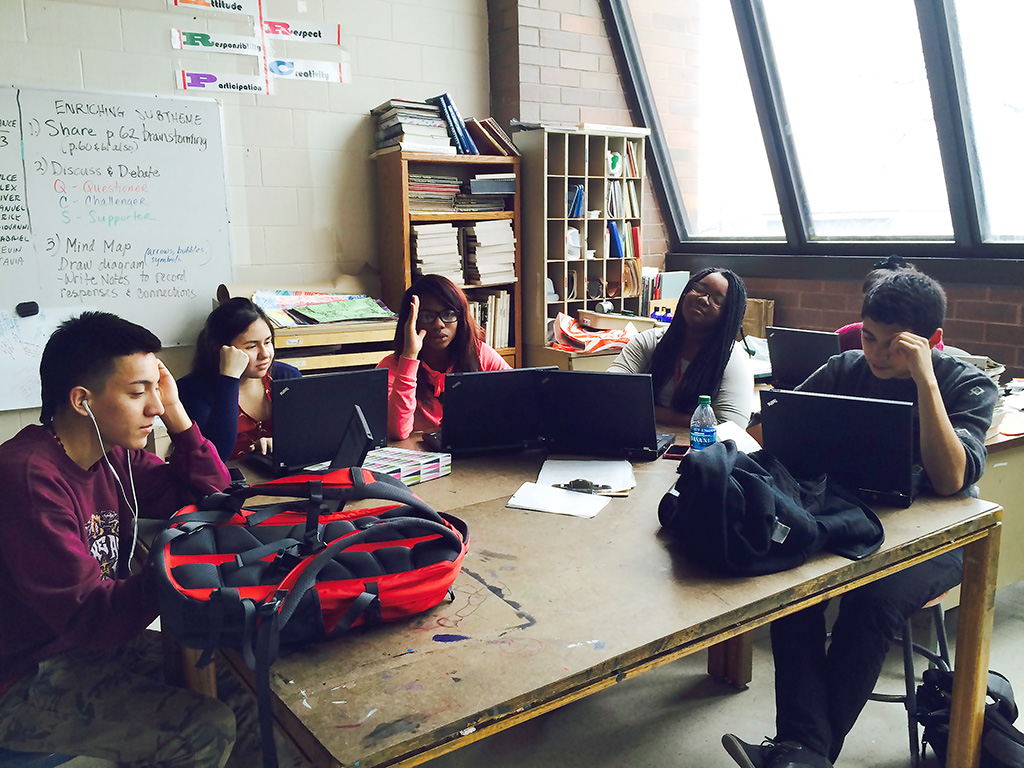
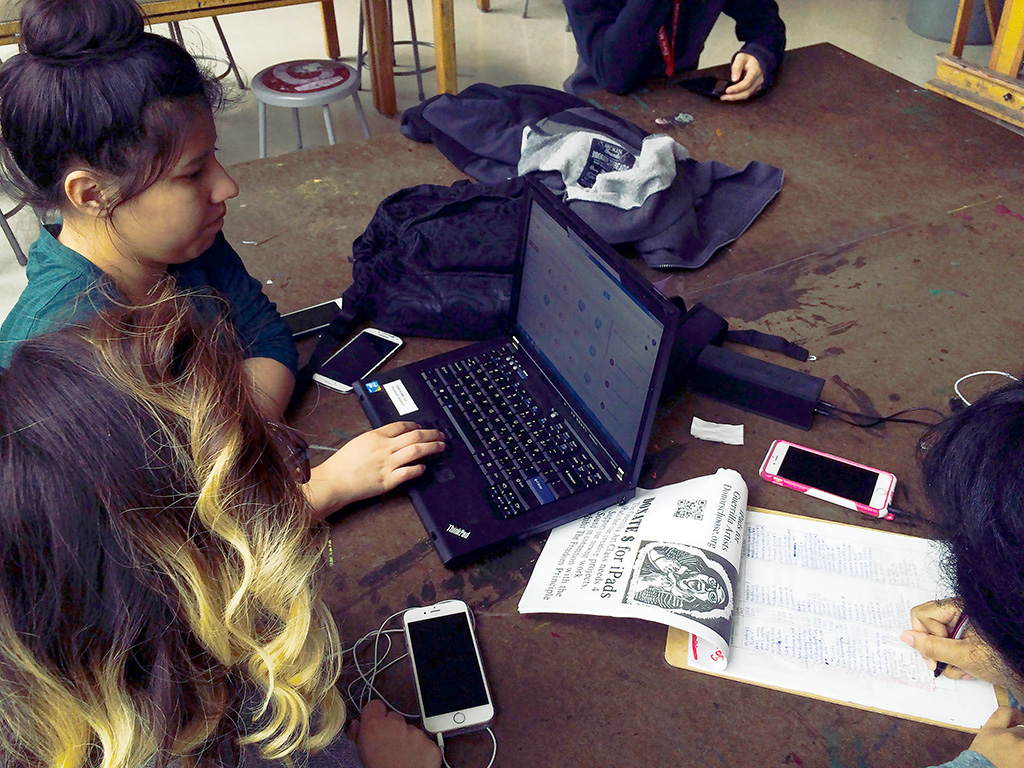
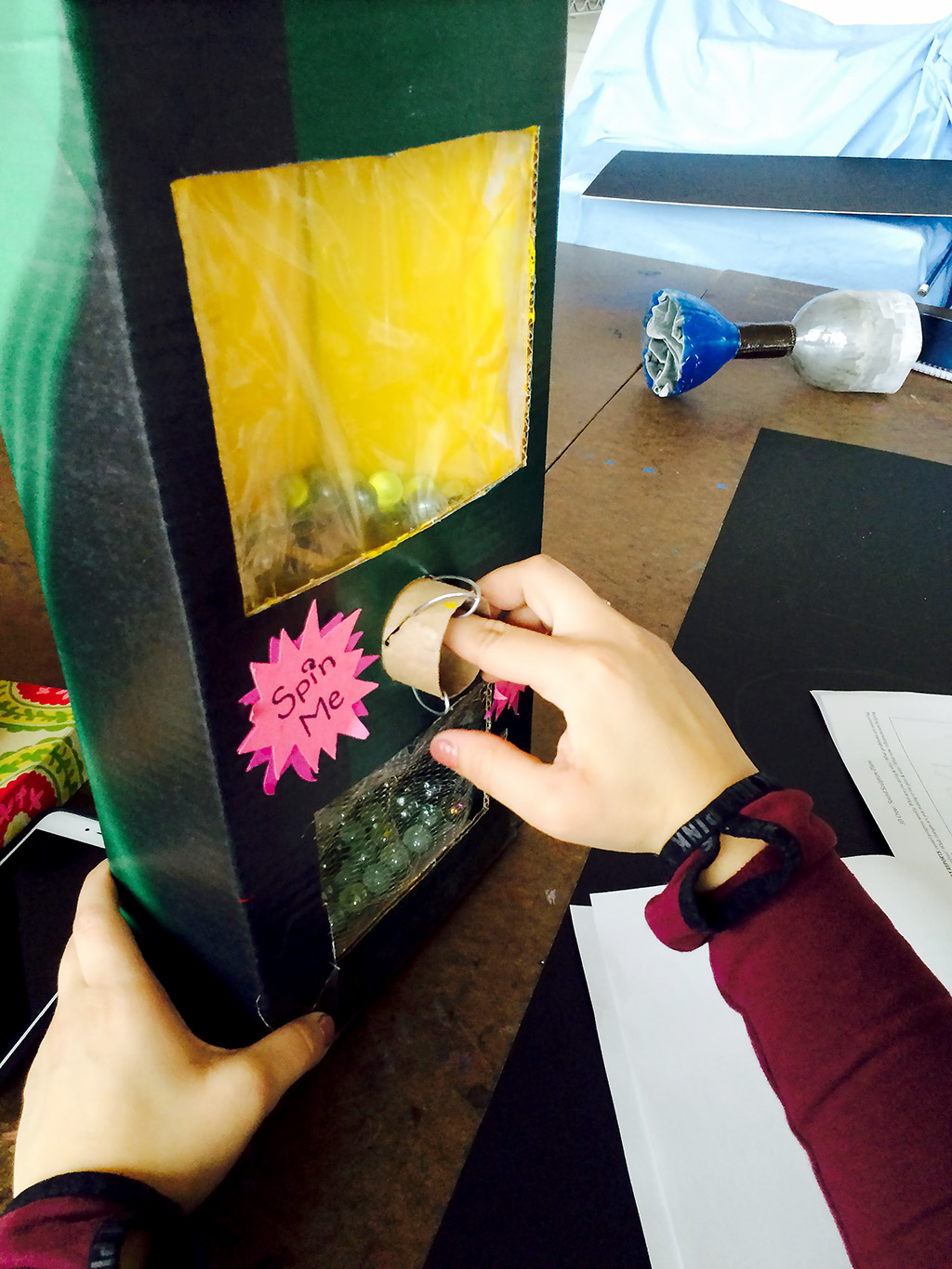
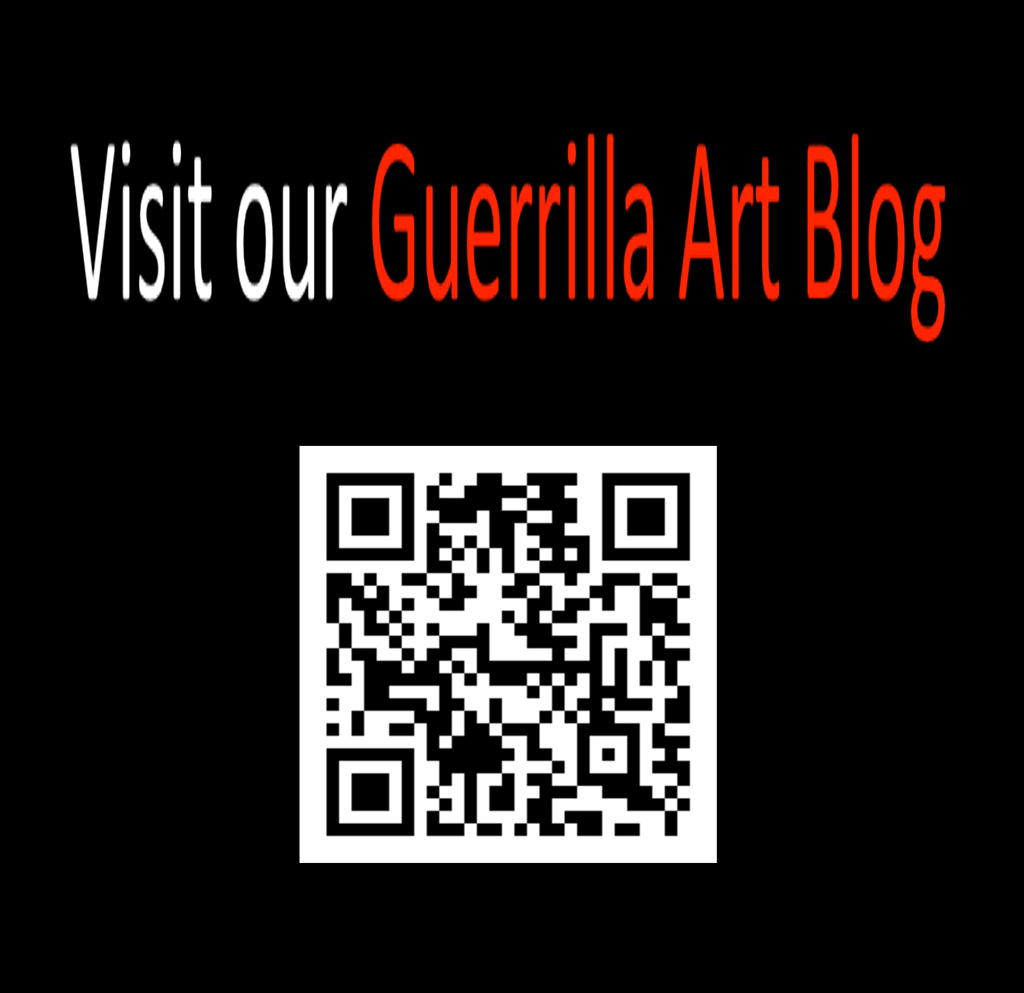
Materials
- 2D: Markers, colored pencils, paints, brushes, palettes, stencils, sponges, packing tape, glue sticks, etc.
- 3D: Cardboard, x-acto knives, dowel rods, grommets, saws, drills, epoxies/adhesives, glue guns, duct tape, plastic, recycled materials, PVC pipes & connections.
- Digital: Computers, apps (Garageband, Google Drive), smartphones, iPads, video camera.
MCA Connections
The Freedom Principle exhibition artworks served as inspiration for students’ intention, practice, media choice, and process in the creation of socially engaged artwork that used sound and visuals to activate a space with a specific message.
Students were specifically inspired by: Jamal Cyrus, Untitled (2010); Roscoe Mitchel, Percussion Cage (2003); Lewis Ewert, Repetto, Rio Negro II (2007/2015); La Grande Orielle; Lisa Alvarado, Represencing (2011);Terry Adkins, Native Son (Circus); Matana Roberts, always say your name (2014); Anthony Braxton’s Visual Scores; and resident artist Mikel Patrick Avery’s use of “non-musical” objects to create musical sound.

Valerie Xanos
Curie Metro High School
Growing up an artist on the Southwest side of Chicago isn’t easy. There isn’t much exposure to the arts down there. Valerie Xanos became a teacher in the public school system to be an agent of change for young artists. Valerie grew up and still lives where she teaches, sharing a connection to her students through community. A 17-year veteran of CPS, her BFA and teaching certificate were earned at The School of The Art Institute of Chicago and The Glasgow School of Art. As an artist, she works in the media of paint, collage, and photography. Interested in the Guerrilla Art movement, she uses this to influence her curriculum. It is a wonderful genre to affect social change through art in the community. She teaches two Guerrilla Art classes at Curie High School; you can see their art on student blogs: (links:http://guerrillaart4.blogspot.com text:Guerrillaart4 popup:yes) and (links:http://guerrillaart5.blogspot.com caption:Guerillaart5 popup:yes). She is also a mother of four amazing, willful, active young adults. They are often an inspiration to Valerie as a teacher.
Valerie reflects on her process:
Students determined that the arts are absent from their world because of a lack of awareness and advocacy. After exploring John Cage’s 4’33”, one student, Xena, cried out, “WE are the symphony!” This led to students’ realization that they could use sound in conjunction with visual artworks to publicly advocate for the arts. By making the arts seen and heard through an interactive, participatory performance installation of the Sound Sculptures and Soundscape, students made their voices heard, and their values known. Students had complete autonomy and creative control throughout the process as members and leaders of the collective. This made the artworks more personal and meaningful to the students, while empowering them as advocates for the arts. During this project, I was out for two months on medical leave. I had to trust the students, putting the project entirely into their hands to develop the lesson on their own. The collective successfully worked to continue the Sound Sculpture lesson during my absence, creating the prototype works in time for my return.